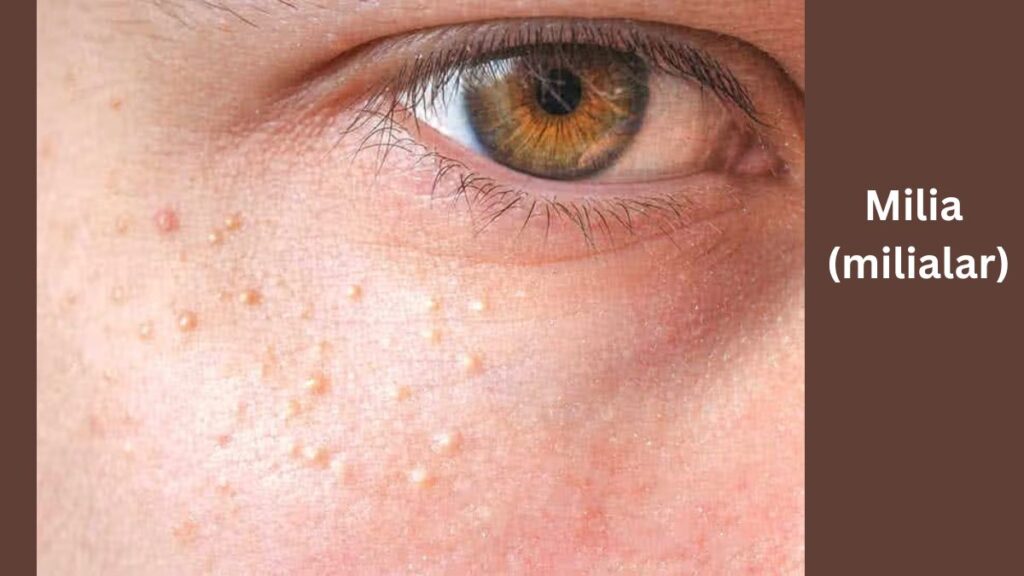Small, innocuous-looking bumps that sometimes appear on the skin can leave many people puzzled. These tiny bumps, known as Milia (milialar), are a common skin condition that can affect individuals of all ages. In this article, we will delve into what Milia are, their causes, identification, prevention, and treatment options to help you understand and manage these skin inconveniences.
Contents
What are Milia(milialar)?
Definition of Milia
You can find milia, pronounced “mil-ee-uh,” anywhere on your body, but they most commonly appear on your face. “Milk spots” are a result of trapped keratin, a protein found in the skin’s outer layer, and are a common cosmetic concern.
Types of Milia
Neonatal milia, which affects newborns, primary milia, which affects children and adults, and secondary milia, which affects people who have already suffered skin damage. The causes and defining features of each variety are different.
Causes of Milia (milialar)
Excessive Oil Production
The overactive oil glands in the skin are a major contributor to Milia. Milia can form when this excess oil gets trapped under the skin’s surface.
Skin Care Products
Milia can be exacerbated by the application of thick, oil-based skin care products. These products may clog pores, hindering the skin’s natural exfoliation process.
Sun Damage
Sun damage can make the skin more thick and resistant to exfoliation. This can cause Milia by trapping skin cells.
Identifying Milia (milialar)
Characteristics of Milia
The typical size of a milia is only a millimeter or two, and they have a very light coloration or are completely white. They look like whiteheads but don’t cause any irritation or redness, so people frequently get them confused.
Differences from other skin conditions
The skin condition known as Milia must be differentiated from acne and sebaceous hyperplasia. Milia, in contrast to blackheads and acne, do not have a pore at their center.
Preventing Milia (milialar)
Proper Skincare Routine
Maintaining a proper skincare routine, including gentle exfoliation and the use of non-comedogenic products, is essential for avoiding Milia. Milia can be avoided by maintaining a regular routine of exfoliation.
Sun Protection
The use of sun protection is also important in the fight against Milia. Sun damage can cause Milia, so it’s important to use sunscreen every day.
Treatment Options
Home Remedies
Home remedies, such as warm compresses and gentle exfoliation, can be effective for mild cases of Milia. Squeezing or popping Milia can cause scarring and infection, so it’s important to avoid doing so.
Professional Treatments
Dermatologists provide safe removal of Milia through the use of microdermabrasion, chemical peels, and lancing. Only a trained medical expert should administer these procedures.
When to Consult a Dermatologist
Consult a dermatologist if your Milia symptoms are severe or persistent. They have the ability to diagnose the problem correctly and offer helpful treatment suggestions.
Myths and Misconceptions
Toothpaste as a remedy
Applying toothpaste to Milia, as is commonly believed, will not help. Worse, it can irritate the skin, making the problem even worse.
Milia being acne
Acne and milia are two different skin conditions, despite their similarities. Milia are caused by trapped keratin, while acne is caused by blocked pores.
Conclusion
Milia (milialar), or subcutaneous bumps, are fairly common but can be treated successfully. You can maintain healthy skin by learning about these conditions and the steps you can take to avoid or treat them. Always seek the advice of a dermatologist if you have any concerns about your skin.
FAQs
- What do Milia look like?
Milia appear as small, white or flesh-colored bumps on the skin. They are often mistaken for whiteheads.
- Can Milia go away on their own?
Milia can sometimes resolve on their own, but if they persist or bother you, it’s best to seek treatment.
- Are Milia painful?
Milia are typically painless. They are more of a cosmetic concern than a source of discomfort.
- Can adults get Milia?
Yes, Milia can affect individuals of all ages, including adults.
- Are there any risk factors associated with Milia?
While Milia can affect anyone, they are more common in individuals with certain skin types and those who use heavy skincare products.

